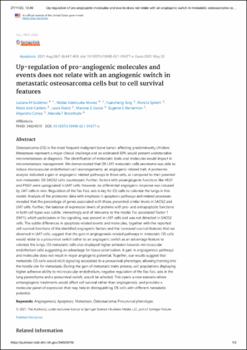| dc.description.abstract | Abstract
Osteosarcoma (OS) is the most frequent malignant bone tumor, affecting predominantly children. Metastases represent a major clinical challenge and an estimated 80% would present undetectable micrometastases at diagnosis. The identification of metastatic traits and molecules would impact in micrometastasis management. We demonstrated that OS LM7 metastatic cells secretome was able to induce microvascular endothelium cell rearrangements, an angiogenic-related trait. A proteomic analysis indicated a gain in angiogenic-related pathways in these cells, as compared to their parental-non-metastatic OS SAOS2 cells counterpart. Further, factors with proangiogenic functions like VEGF and PDGF were upregulated in LM7 cells. However, no differential angiogenic response was induced by LM7 cells in vivo. Regulation of the Fas-FasL axis is key for OS cells to colonize the lungs in this model. Analysis of the proteomic data with emphasis in apoptosis pathways and related processes revealed that the percentage of genes associated with those, presented similar levels in SAOS2 and LM7 cells. Further, the balance of expression levels of proteins with pro- and antiapoptotic functions in both cell types was subtle. Interestingly and of relevance to the model, Fas associated Factor 1 (FAF1), which participates in Fas signaling, was present in LM7 cells and was not detected in SAOS2 cells. The subtle differences in apoptosis-related events and molecules, together with the reported cell-survival functions of the identified angiogenic factors and the increased survival features that we observed in LM7 cells, suggest that the gain in angiogenesis-related pathways in metastatic OS cells would relate to a prosurvival switch rather to an angiogenic switch as an advantage feature to colonize the lungs. OS metastatic cells also displayed higher adhesion towards microvascular endothelium cells suggesting an advantage for tissue colonization. A gain in angiogenesis pathways and molecules does not result in major angiogenic potential. Together, our results suggest that metastatic OS cells would elicit signaling associated to a prosurvival phenotype, allowing homing into the hostile site for metastasis. During the gain of metastatic traits process, cell populations displaying higher adhesive ability to microvascular endothelium, negative regulation of the Fas-FasL axis in the lung parenchyma and a prosurvival switch, would be selected. This opens a new scenario where antiangiogenic treatments would affect cell survival rather than angiogenesis, and provides a molecular panel of expression that may help in distinguishing OS cells with different metastatic potential.
Keywords: Angiogenesis; Apoptosis; Metastasis; Osteosarcoma; Prosurvival phenotype.
© 2021. The Author(s), under exclusive licence to Springer Science+Business Media, LLC, part of Springer Nature. | es |


